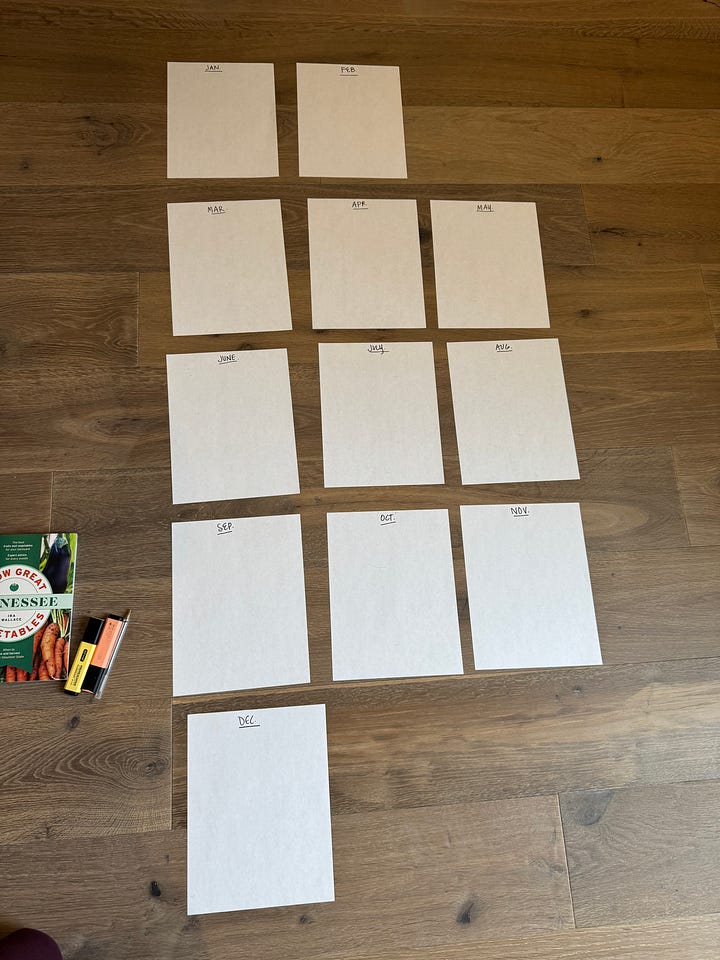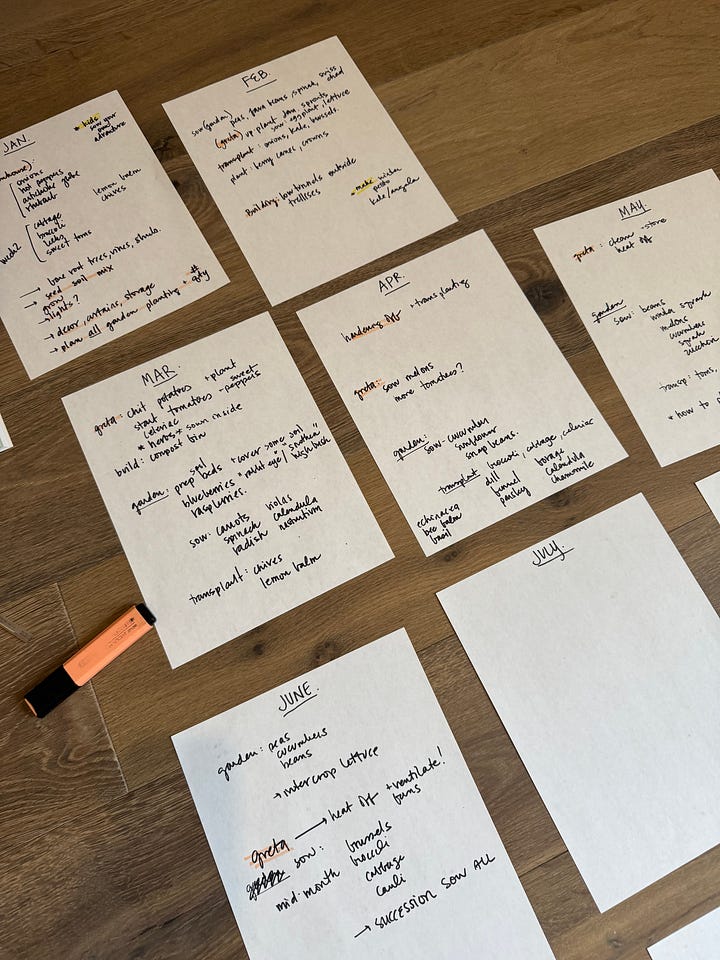Behind the Scenes Weekly Update & Winter Gardening
Our homestead update and a quick guide to growing vegetables, herbs, and flowers in winter
Hello, My Love!
But, how are you? Christmas is coming up quickly and I bet not a single one of you feels like you have it all together, because it’s impossible to. Some days I question my actual sanity because I have chosen a life that requires a lot of extras. For example, this week I desperately need to get some quotes for wood to build our new raised beds so that we can install irrigation so that I can garden. And also this week one child already has some sort of fevered illness, so there’s a chance more dominoes will fall. I also want to make neighbor gifts and host a solstice night with my kids. It’s the extras that make life so special, but it’s also what’s giving me gray hair.
This full, beautiful, extra steps life is in fact what I always wanted, so in these moments the “choose your hard” quote rings true. I would have it no other way. I’m sending everyone my best wishes, heaps of patience, and a reminder that Dollar Tree is the best place to get stocking stuffers, second only to Cost Plus World Market, though you’ll go broke instantly by going to the latter.
In the garden: This week is one of transition in our own garden as we wait to get our raised beds built … by our own darn selves. I need to find the right wood in the right sizes. I’m delaying because quite frankly, math makes me sad. There’s so much critical thinking involved when I’m much more of a dash of this, a dash of that kind of person. Such is life.
The chickens: While sourcing wood for the beds, and potentially some stone for some too, we need to relocate the chicken coop. It was delivered to us and is stunning and … huge. I’ll have to have it properly repositioned so as not to offend the neighbors. It sits directly in their line of sight. We want to straighten it out and have it sit amongst the trees to provide shade for the chickens in the summer.
Speaking of chickens, getting them in winter is not exactly ideal. We’ve (my “we” I mean me) decided that starting with pullets is the best course of action to get some experience and some eggs faster. Chicks in the cold is not a recipe for success, so more mature chickens is a great call. I’m worried they won’t take to the kids as much, but we’ll just have to see. We can always snag some spring chicks too. I’m being told that chickens are like tattoos - once you get one, you want more. We shall see!
In the greenhouse: we have action and I completely lost my mind with excitement at seeing my first seeds sprout (photo evidence below). I started some radicchio, lettuce, and spinach out there and it’s all popping up! You can see me live-reacting in this video on Instagram - the joy is unmatched.
I keep starting more and more seeds because I’ve been so garden-deprived and it’s safe to say I haven’t lost my green thumb, though I was starting to get nervous about it.
Garden planning: I also started mapping out how I’m going to tackle next year and got some month-by-month ideas down. I also have a sort of secret meeting with a videographer this week and needed some solid concepts down on paper, soooo … yeah, exciting stuff!
I used two books to help me get my mind in the right headspace. One is the Floret Flower Cut Flower book and the other is all about vegetable gardening in Tennessee since I don’t have my Zone 7 experience dialed in yet.
I basically write down everything I want to accomplish for the month on a sheet of paper and then one month in advance of that, assemble anything that I need to meet my goals. I lay the paper out in accordance to the Gregorian calendar, but also the seasons. I want to do a live call about this, so stay tuned for dates on that coming!


Contrary to popular belief, we CAN grow things in the winter, even without a greenhouse. In all three of our favorite categories: vegetables, herbs, and flowers, there is something to do. These are what I’d consider the last tasks of the 2024 garden and from here on out, we’ll do 2025 things (like planning, prep, etc.). So this is the final push before we turn a new leaf (pun intended).
Back when I lived in California there was a huge margin for error. I could really push the boundaries on when plants were started. Now that I live in a real climate (let’s be honest, year-round perfect weather is just crazy), I can see how much strategy goes into getting things to thrive without warmth.
This is why I refer to gardening as co-creation. So much is out of our control, so we must learn to observe and respond, plan and pivot.
Let’s dig into winter gardening, shall we?

Vegetables
Ah, the elusive winter veggies! Really it’s more like winter greens. They’re full of vitamins which is quite helpful in the winter when we’re getting much less from our food. Some vegetables that you can grow fall into three categories:
Quick-growing greens: Spinach, arugula, and mesclun mix.
Cold-tolerant crops: Kale, Swiss chard, and mustard greens.
Root crops (for regions with mild winters): Radishes, turnips, and carrots in a cold frame or tunnel.
To dig deeper, let’s explore how to actually grow everything.
For the quick-growing greens, if you’re growing these outdoors you still need some protection from frost. That means an unheated greenhouse, cold frames, or low tunnels. If you’re growing indoors, you need grow lights near a sunny south-facing window.
When you’re sowing seeds for these plants, keep them shallow-sown (which is normally what they call for), in good loose soil, and succession sow them every two weeks to keep production up.
Water these regularly so that the soil doesn’t dry out, but avoid water-logging. Less is more in winter so you don’t get root rot.
Cold-tolerant crops can grow outside in the elements, but you still need row covers to protect them from actual snow. Cold frames are beneficial as well to maintain higher temps. I used to use this tiny greenhouse in California called a “countertop greenhouse” and it was fabulous for cold weather growing. This on a larger scale would be like a coldframe.
Mulch is important here, as it will add warmth to your beds. Cold-tolerant plants can endure some light frost down to 20°F or -6°C, but use that mulch, row covers, or frames for extended freezes.
Harvesting these crops is all about tender baby greens OR going for that over-wintering sweetness. Pick your path based on what you’ve grown. Root crops I would leave, and leafy greens I would harvest young.
A NOTE ABOUT PESTS:
Even in winter, we get pest pressure. Monitor for aphids and slugs especially. I do not like Neem oil typically but when there aren’t pollinators in the mix, I’d say just at dunks a touch would be okay for aphids control. Though a heavy stream of water when you first notice them is better.
Herbs
Nothing has been harder for my morale than having to buy herbs. Even from local farms. We typically always have herbs! However, these can be some of the easiest things to get growing and going through winter.
Additionally, herbs are the least diva and most useful. They’re the actual MVP of nature. Healing us, flavoring food, and being easy to keep alive. This is the shortest segment because herbs are dare I say … easy.
If you’re growing indoors: Basil, chives, parsley, cilantro, and dill (using grow lights) are your friends. You need a good indoor grow light system (Amazon has this) and to water them only occasionally. Herbs don’t love to be wet, so they can be nice and hands-off. They just need the consistent light and warmth of your home.
If you’re growing outdoors, thyme, sage, and oregano are cold-tolerant. Treat them like your cold-tolerant veggies (above) and just don’t let a hard freeze get to them.
Flowers
Okay, we are admittedly a bit late to the game with flowers. However, all is not lost and I wanted to get this to you nonetheless. There’s still much to do! There are two real approaches when it comes to flowers:
Forcing bulbs indoors: Amaryllis, paperwhites, hyacinths, and tulips.
Winter sowing for spring blooms: Snapdragons, sweet peas, and foxgloves in milk jugs or cold frames
Here is how we get down to the root of it. Flower selection and then prep are where it’s at. You know I love ChatGPT and this would be a great time to use it! To help you get to know what exactly grows well in your zone. Not all flowers thrive in winter, so focus on cold-tolerant species or those suited for indoor forcing.
Outdoor Winter Flowers
Hardy Annuals: Pansies, violas, snapdragons, sweet peas, calendula, and alyssum.
Perennials: Hellebores, snowdrops, and winter jasmine.
Indoor Forcing Bulbs
Popular Choices: Amaryllis, paperwhites, hyacinths, tulips, and crocus.
These can be coaxed into blooming indoors in late winter with proper preparation.
Outdoor Soil Preparation
Enrich the soil with compost to provide nutrients.
Ensure proper drainage to prevent roots from freezing.
Use mulch (2–3 inches thick) around plants to insulate roots and retain moisture. I like to use straw mulch.
Indoor Containers
Use high-quality potting soil.
Ensure pots have drainage holes to prevent waterlogging.
Mix in perlite or sand for additional drainage, especially for bulbs.

Techniques for Outdoor Winter Flower Growing
Cold Frames or Greenhouses
Protect flowers from frost and extreme temperatures.
Ideal for hardy annuals like snapdragons or sweet peas.
Mulching and Row Covers
Use mulch to protect the root zones of perennials that are out in the elements.
Cover with lightweight frost cloth or row covers to prevent frost damage while still allowing light through.
Winter Sowing
For hardy annuals or perennials, sow seeds in milk jugs or cold frames in December.
Seeds will naturally stratify (a period of cold to trigger germination), ensuring strong growth in early spring.
Techniques for Indoor Winter Flower Growing
Forcing Bulbs
Step 1: Prepare Bulbs
Use pre-chilled bulbs or chill them yourself (place in a refrigerator for 10–14 weeks at 35–45°F/1–7°C).
Choose containers that are shallow and wide for bulbs like hyacinths or deeper for amaryllis. Thrifting these vessels can be wildly fun - or use something you already have.
Step 2: Planting
Plant bulbs in an organic potting mix, leaving the tips exposed.
Water thoroughly after planting.
Step 3: Encourage Growth
Place the pots in a cool, dark place for 4–6 weeks to allow root development.
Move to a bright, warm location when shoots are 1–2 inches tall.
Step 4: Maintenance
Provide 12–16 hours of light using grow lights if natural sunlight is insufficient.
Keep the soil moist but not waterlogged.
Step 5: Enjoy Blooms
Flowers will bloom in 6–8 weeks after being moved to warmth and light.
Light Requirements
Outdoor flowers need full sun in winter, so position cold frames or greenhouses accordingly.
Indoor flowers benefit from south-facing windows or grow lights for 12–16 hours a day.
Temperature Control
Hardy outdoor flowers tolerate light frosts but struggle in prolonged freezes. Use frost cloth or portable greenhouses to buffer extreme cold.
Forcing bulbs indoors requires temperatures between 60–70°F for optimal blooming.
Watering
Outdoor Flowers
Water deeply but less frequently to prevent freeze damage to roots.
Indoor Flowers
Avoid overwatering to prevent root rot, especially in bulbs.
Strategic Planning for Continuous Blooms
Succession Planting: Stagger planting times for hardy flowers and bulbs to ensure continuous blooming.
Companion Planting: Pair flowers that bloom at different times to create visual interest throughout the winter.
Maintenance and Troubleshooting
Monitor for Pests: Indoors, watch for aphids and spider mites. Outdoors, keep an eye on slugs or voles near mulch.
Deadheading: Remove spent blooms to encourage new flowers and maintain appearance.
Check for Frost Damage: Prune affected areas once the plant begins growing again.
Example of a Fun Winter Flower Setup
Outdoors: A raised bed with violas, snapdragons, and hellebores under a low tunnel.
Indoors: A tabletop display of amaryllis, paperwhites, and forced tulips for a burst of mid-winter color.
I will personally be starting seeds in my greenhouse this winter and maybe maybe maybe can maybe get things going outside, but most likely won’t stress over it. Our kitchen garden is still being built, so the jury is out on when those beds will be workable.
We do however always start some bulbs inside as they bring so much joy on the day the blooms finally emerge. I’ll also get some herbs going in the greenhouse that we will transfer outdoors, and then keep outside as long as possible. This will be a bit of a hardening-off process.
Alongside seed starting, I’ll be cleaning and sanitizing all my tools and planting trays, ordering the best compost that I can find, and making a compost bin area on our homestead - that needs to happen ASAP!
If you have any winter gardening questions, let me know! That was a lot of info. I just wanted to get a good base started for our winter together. December marks the end of the growing season in my opinion and once you have anything sown that you want in the ground, you’re going to be future-forward and planning for the next year.






